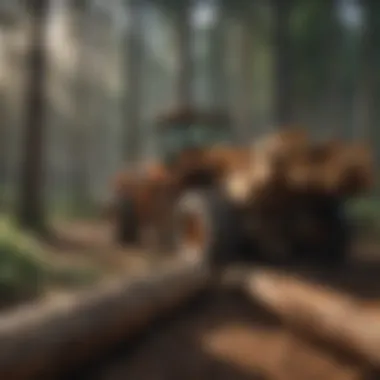Understanding Log Skidders in Sustainable Forestry


Intro
Log skidders are vital machinery in the forestry sector. Their primary role is to transport logs from the harvesting area to the roadside or landing where they can be further processed. Understanding the function and significance of these machines provides valuable insights for both forestry professionals and those interested in sustainable practices. In recent years, the evolution of log skidders has aligned closely with a growing understanding of the need for sustainable timber harvesting, making their study particularly relevant.
Overview of Forestry Practices
Forestry practices encompass the management of forests aimed at meeting both ecological and economic goals. The work involves more than just cutting down trees. It includes careful planning and execution to ensure forests remain healthy and productive.
Importance of Forestry
Forests are critical to the environment. They provide habitat for wildlife, help in carbon sequestration, and reduce soil erosion. The economic benefits include timber production, recreation, and tourism. More than ever, properly managed forestry practices can yield timber while preserving the ecological integrity of the forest.
Types of Forestry Practices
- Natural Forest Management: Focuses on maintaining the forest's biodiversity. This method encourages natural regeneration and minimizes human intervention.
- Plantation Forestry: Involves growing tree species specifically for timber production. These plantations can lead to higher yields per acre but require careful management to avoid negative ecological impacts.
- Agroforestry: Combines agriculture and forestry practices. This method increases biodiversity and improves land productivity.
The Role of Log Skidders in Each Practice
Log skidders are used in all types of forestry practices. However, their application differs based on the methodology employed. For instance, in natural forest management, skidders must be used minimally to avoid damaging the surrounding ecosystem, while in plantation forestry, they can operate more intensively, provided that their use is planned and managed carefully.
Best Practices for Sustainable Woodland Stewardship
Sustainable woodland stewardship is essential for ensuring the longevity of forest resources. It requires balancing wood production with environmental health.
Principles of Sustainable Forestry
- Conservation of Biodiversity: Protecting various species and their habitats is crucial.
- Ecosystem Health: Monitoring tree health and soil conditions aids in sustaining forest ecosystems.
- Social and Economic Benefits: Engaging local communities in forestry practices bolsters their significance.
Techniques for Land Management
- Selective Logging: Rather than clear-cutting, this technique involves strategically removing trees. This method preserves the ecosystem and promotes regeneration.
- Controlled Burns: Used to manage underbrush and reduce fire risks, these burns can invigorate forest growth when done correctly.
Innovative Techniques in Forestry
As technology continues to evolve, forestry practices, including log skidding, are benefitting from new methodologies that enhance efficiency and sustainability.
Latest Technological Advancements
- Automation: Remote-controlled and automated skidders can operate in challenging terrains, reducing labor costs.
- GPS Technology: Allows log skidders to navigate more efficiently, minimizing environmental disturbances.
Integrating Traditional Knowledge with Modern Science
The best outcomes in forestry often arise from combining traditional practices with modern science. Local knowledge can guide effective forest management, while scientific data can optimize these practices. This integration leads to a more holistic approach.
"Integrating old knowledge with new technology can reshape forestry practices for a sustainable future."
Intro to Log Skidders
Log skidders are a crucial component of the forestry industry, playing a significant role in timber harvesting. These machines assist in efficiently transporting logs from the cutting area to a landing site, which is the site where logs are loaded onto trucks. The introduction of log skidders has evolved over time, aligning with advancements in technology and increasing demands for sustainable practices in forestry.
Understanding log skidders is vital for forestry professionals, as their operational mechanics and design influence the effectiveness of timber extraction. As global awareness of environmental sustainability grows, there is increased scrutiny on how logging practices impact ecosystems. Log skidders can either mitigate or exacerbate these effects. Thus, a thorough comprehension of how these machines function is central to improving efficiency while minimizing environmental harm.
Definition and Purpose
A log skidder is a type of heavy machinery designed to haul logs from the forest to a specified location. It typically operates by using a cable to drag the logs along the ground or by using wheels or tracks to transport them.
The primary purpose of a log skidder is to increase productivity during logging operations. As trees are harvested, getting the logs out of the dense forest is often a challenging task due to terrain and accessibility issues. Log skidders make this process more efficient by allowing one operator to move multiple logs with a single machine. This efficiency reduces the need for manual labor and enhances the economic viability of logging operations.


Historical Development
The evolution of log skidders reflects broader technological advancements throughout the forestry industry. Early logging relied heavily on manpower and basic tools. The adoption of animals, such as horses and oxen, was the first significant change that improved the ability to move heavy logs.
With the advent of mechanization in the early 20th century, gasoline-powered log skidders began to emerge. These machines offered operators greater power and efficiency. Throughout the 20th century, improvements continued with the introduction of hydraulic systems and modern safety features. Today, log skidders are equipped with advanced functionalities, including automated controls and smart technology which enables real-time data gathering for better operational efficiency.
Understanding how log skidders have evolved is crucial for professionals in the field. These developments not only enhance productivity but also address the growing concerns around environmental sustainability and operational cost-effectiveness in timber extraction.
Types of Log Skidders
The various types of log skidders are essential in the forestry industry. Understanding these types helps in selecting the appropriate machinery for specific logging tasks. Each type brings unique characteristics that benefit different environments and operational needs. This knowledge also highlights important considerations regarding efficiency, cost, and environmental impacts.
Cable Skidders
Operational Mechanisms
Cable skidders utilize a winch system for pulling logs from the logging site to the landing area. The primary mechanism includes a steel cable that loops around the log, allowing it to be dragged without the skidder needing to move directly over the timber. This feature makes cable skidders invaluable for steep terrains, as they can operate effectively without causing significant ground disturbance. Their capability to access hard-to-reach locations provides a distinct advantage in logging operations.
Benefits and Drawbacks
Cable skidders offer several benefits. Their low impact on the environment is one key aspect, as they cause minimal soil compaction. They can operate in wet conditions where heavier machinery may struggle. Conversely, cable skidders present drawbacks. They require a more skilled operator to navigate effectively, and their operational speed is generally slower compared to wheeled or tracked skidders. Balancing these benefits and drawbacks is crucial for making informed decisions in forest management.
Wheeled Skidders
Characteristics and Use Cases
Wheeled skidders are characterized by their agile mobility, powered by rubber tires. This design allows for faster operation across various terrains. They are commonly used in more accessible forestry sites. Their efficiency in straight-line pulls makes them a favorable choice for log removal in open spaces. In addition, wheeled skidders can pivot easily, improving maneuverability in tight areas. However, their effectiveness may be limited in particularly rutty or steep terrains, where traction may be compromised.
Efficiency Metrics
Efficiency metrics for wheeled skidders are significant in assessing performance. Factors such as cycle time and fuel consumption are critical indicators. Comparatively, wheeled skidders often require less fuel than tracked alternatives, promoting sustainability in logging activities. Their overall productivity is linked to their speed and payload capacity, making them a common choice for many logging operations. Nonetheless, regular maintenance is essential to maintain their efficiency, especially when used in challenging conditions.
Tracked Skidders
Advantages in Rugged Terrain
Tracked skidders are designed with heavy-duty tracks that distribute the machine’s weight more evenly. This design allows them to navigate rugged terrains more effectively than other types. Their low ground pressure helps minimize soil disturbance, making them ideal for logging in sensitive ecological areas. Such advantages make tracked skidders essential in environments where other machinery may become stuck or cause damage.
Maintenance Considerations
Maintenance is a critical aspect of utilizing tracked skidders. Regularly inspecting the tracks is vital, as wear can lead to performance issues. Maintenance intervals and the complexity of repairs can vary based on usage and terrain. While they are durable, the cost of repairs can be higher due to the sophistication of the equipment. Encouraging proper servicing schedules and careful operation can ensure longevity and optimal functioning of tracked skidders.
Operational Efficiency in Log Skidding
Operational efficiency in log skidding plays a crucial role in the forestry industry. This efficiency directly impacts productivity, cost-effectiveness, and sustainability. Log skidders, equipped with the right techniques and practices, can significantly enhance their operational output. Efficient log skidding not only ensures that timber harvesting is conducted with minimal environmental disruption but also aligns with the economic expectations of forestry operations.
Techniques for Maximizing Productivity
Planning and Layout
Planning and layout are fundamental in log skidding operations. A well-thought-out plan optimizes the movement of machinery and logs around a forest site, reducing travel time and maximizing efficiency. The key characteristic of effective planning is that it takes into account terrain types, access routes, and operational zones. This strategy is a popular choice in this article because it fundamentally improves workflow.
The unique feature of effective planning is its adaptability. Depending on the site conditions and log type, operators can make decisions that best suit their needs. The advantages of solid planning include reduced fuel consumption and less wear on machinery, but it also requires thorough knowledge of the area being worked in, which can be a disadvantage for less experienced operators.
Timely Operations
Timely operations are essential for maximizing the effectiveness of log skidding processes. Timing refers to the scheduling of tasks such as the felling, skidding, and loading of logs. The key characteristic of timely operations is their focus on efficiency and coordination. This method is beneficial because it ensures that equipment is used at its optimal capacity.
A unique feature of this approach includes the integration of weather patterns and market demand, allowing operators to work under favorable conditions. The advantages of timely operations are clear: increased productivity and reduced logistical challenges. However, the disadvantages may include the risk of rushing processes, which could result in accidents or subpar performance.


Fuel Efficiency and Sustainability
Fuel efficiency is an increasingly important aspect in log skidding. It links directly to sustainability practices within the forestry sector. Implementing fuel-efficient strategies promotes responsible resource use while reducing operational costs. It also aligns with growing environmental expectations from various stakeholders.
Best Practices
The concept of best practices in fuel efficiency includes several measures that companies can adopt. For example, regular maintenance of machinery ensures optimal performance, which leads to lower fuel consumption. The key characteristic of best practices is their evidence-based nature, relying on data from past experiences to inform current choices. This approach is beneficial because it is grounded in results and can be easily tailored to specific workflows.
The unique feature of best practices in fuel efficiency is their comprehensive nature; they cover everything from machinery selection to operational techniques. Their advantages include improved profitability and reduced negative environmental impacts, while disadvantages can emerge if proper protocols are not followed, resulting in ineffective processes.
Comparative Analysis of Models
Comparative analysis of models allows forestry professionals to evaluate the efficiency of different skidding machinery under various conditions. This evaluation helps to establish benchmarks and identify the best options for specific operational needs. The key characteristic of this analysis is its data-driven focus, which leads to informed decision-making.
A unique feature of comparative analysis is its potential to reveal unexpected trends, such as the performance advantages of a newer model over an established one. The advantages of this approach include making strategic investment decisions based on empirical evidence. However, reliance solely on comparisons can lead to overlooking other critical factors, such as terrain and operator skill, as disadvantages.
Environmental Impact of Log Skidders
Understanding the environmental impact of log skidders is crucial for several reasons. First, these machines play a key role in timber harvesting. However, their operations can lead to significant disturbances in the ecosystems where they function. This section reviews the complexities regarding soil compaction, erosion, and biodiversity impacts stemming from log skidding activities. It also explores strategies for mitigating these effects, ensuring that forestry practices remain sustainable and responsible.
Soil Compaction and Erosion
Mechanisms of Affectation
Soil compaction occurs when heavy machinery compresses the soil, reducing its porosity and aeration. This alteration in soil structure leads to challenges in water infiltration and root growth. Compaction primarily affects topsoil, which is essential for healthy vegetation. The unique feature of soil compaction is its immediacy; it happens quickly during operations. The contributing factors include the weight of the skidders and the moisture content of the soil. Proper management thus becomes critical to maintain soil health and ensure ongoing forest productivity.
Mitigation Strategies
Mitigation strategies for soil compaction involve a mix of practices aimed at minimizing disturbance. These may include route planning, using lighter skidding equipment, and employing ground protection mats. A key element of these strategies is their adaptability; they can be tailored to specific logging environments. For example, selecting appropriate times for logging activities based on soil moisture can lessen compaction risks. The unique feature here is the proactive approach to planning, which not only benefits the immediate site but also sustains longer-term forest health. However, implementing these strategies can involve additional costs and training.
Biodiversity Considerations
Species Disruption
Species disruption refers to the negative effects of log skidders on wildlife habitats. This can range from the direct physical removal of trees to changes in soil composition, which affect food sources for various species. A key characteristic of this disruption is its far-reaching impact; it can lead to shifts in local ecosystems. Log skidders can create noise and increase human presence, stressing wildlife. Awareness of this issue is vital. Favorable logging practices seek to minimize habitat loss and provide routes for wildlife movement, but the challenge lies in balancing operational efficiency with biodiversity protection.
Conservative Practices
Conservative practices are methods designed to reduce environmental impacts during logging. This includes selective logging and maintaining buffer zones near water bodies and critical habitats. The main appeal of these practices is their potential for preserving biodiversity while allowing for resource extraction. Their unique feature is the focus on cooperation between logging operations and conservation efforts. However, they often require a cultural shift in the industry, fostering a mindset where environmental considerations are equally valued alongside productivity goals. The implementation of conservative practices may need substantial regulatory support and continuous evaluation to ensure their effectiveness.
Technological Advancements in Log Skidders
The forestry industry is witnessing rapid changes due to technological advancements in log skidders. These innovations not only improve the efficiency of log gathering but also enhance safety and reduce environmental impact. Staying abreast of these developments is vital for professionals aiming to maintain productivity while adhering to sustainable practices.
Automation and Remote Operation
Automation in log skidders has transformed the way timber harvesting is approached. This technology allows for remote operation of the machines, which can be controlled from a distance. As a result, operators are able to handle challenging conditions without physical presence in potentially hazardous areas. Such systems minimize human exposure to risk, particularly in rough terrains or during inclement weather.
In addition, automated systems enable precise operation of skidders. This leads to better positioning and movement of logs, reducing wastage and improving overall efficiency. Enhanced tracking capabilities allow for real-time monitoring of operations. More precise data can help to optimize routes and reduce fuel consumption as machines operate at peak levels based on set parameters.
Integration with Other Machinery
Integration with other machinery is becoming crucial in log skidding operations. This synergy enables a more efficient workflow, facilitating smoother transitions between different stages of timber harvesting.
Synergies in Forestry Operations
The ability to integrate log skidders with other equipment like forwarders or harvesters stands out as a significant advancement. This integration results in coordinated operations, allowing for a seamless process from harvesting to transporting logs. By using machinery that communicates with one another, forestry operations can reduce delays and improve overall productivity. Importantly, this interconnected approach reflects a shift toward holistic forestry management, which is increasingly sought in the industry.
However, challenges like compatibility between various brands and types of machinery could arise.


Case Studies
Utilizing case studies can provide valuable insights into the practical aspects of technological advancements in log skidders. Real-world examples can demonstrate how specific technologies have enhanced operations in different forestry settings. They often highlight the successes and remaining issues faced by the industry.
A prominent case study may showcase a forestry company that invested in automated skidders. The results could illustrate increased efficiency alongside a lower environmental footprint compared to traditional methods. Understanding these results can guide future investments and adaptations towards better technology.
The overall incorporation of these advancements showcases a promising future for forest industries worldwide. These technologies not only evolve operational capabilities but serve as vital components in fostering sustainability within forestry.
Best Practices for Log Skidding Operations
In the world of forestry, log skidding operations are critical to ensure that timber is harvested efficiently and sustainably. Understanding best practices in this area not only enhances productivity but also addresses safety and environmental concerns. These practices offer a framework that forestry professionals can rely upon to optimize their operations. By adhering to these standards, operators can improve operational outcomes and reduce the ecological footprint of logging activities.
Training and Safety Protocols
The main goal of training and safety protocols is to protect workers and minimize risks associated with log skidding. A well-structured training program equips operators with essential skills and knowledge. Such training includes understanding the equipment, recognizing hazards, and implementing safety measures. Operators who are well-trained are more likely to respond effectively in emergency situations. Safety protocols promote a culture of responsibility, where everyone is aware of their role in maintaining a safe work environment.
Regular safety drills and evaluations should be conducted to ensure that all team members are familiar with up-to-date procedures. Comprehensive training also often covers essential topics like first aid and equipment operation.
Periodic Assessments and Maintenance
Periodic assessments and maintenance are crucial for ensuring that log skidders operate at peak efficiency. Consistency in evaluating machinery leads to prolonged equipment life, reduced downtime, and ultimately lowers operational costs. This practice safeguards the investment put into expensive machinery.
Performance Indicators
Performance indicators are quantifiable measures that evaluate the efficacy and performance of log skidding operations. These indicators can include metrics such as the volume of logs transported per hour, fuel consumption rates, and the operational lifespan of the equipment. By analyzing these indicators, operators gain valuable insights that can guide future decisions.
The key characteristic of performance indicators is their objective nature. They provide clear data that can highlight inefficiencies. Moreover, they can help in benchmarking against industry standards, ensuring that practices align with best operations. With consistent monitoring, forestry professionals can identify issues early, allowing for timely interventions that can prevent costly repairs or replacements.
However, relying solely on performance indicators without understanding the broader context can lead to misinterpretations. It is essential to combine data with operator feedback for a more comprehensive view.
Servicing Timelines
Servicing timelines outline the schedules for maintenance tasks that need to be performed on machinery. Keeping a consistent schedule is critical for preventing unexpected breakdowns. A well-planned servicing timeline contributes to an increase in operational efficiency and extends the equipment's lifecycle.
The key feature of servicing timelines is their structured nature. They provide a roadmap for when checks and services should occur, enabling better resource management. In high-intensity operations, a timely service can be the difference between a productive day and costly downtime.
Nonetheless, the disadvantage can arise when companies overly rely on scheduled timelines, neglecting real-time conditions and demands. An operator may find a machine has specific needs outside the standard timeline and must adapt accordingly.
Future Trends and Directions in Log Skidding
The future of log skidding presents numerous opportunities and challenges. Understanding the trends in this area is crucial for forestry professionals who seek to remain competitive and compliant as regulations evolve. Innovative technologies, changing regulatory environments, and sustainability concerns are shaping the path forward in log skidding operations. By recognizing and adapting to these trends, professionals can enhance efficiency and reduce environmental impact.
Emerging Technologies
Emerging technologies are at the forefront of transforming log skidding operations. The integration of advanced machinery equipped with sophisticated sensors can provide real-time data on operational metrics. Features such as GPS tracking and automated controls improve precision in log handling. Drones, for instance, can assess terrains quickly and accurately. Furthermore, software solutions that analyze data help in planning efficient routes for skidders, thus optimizing time and resource usage.
Another significant technology advancement involves the use of electric-powered skidders. These machines produce lower emissions than their diesel counterparts and can significantly reduce operational costs over time. Adapting to alternative energy sources aligns with global initiatives aimed at reducing carbon footprints. Adoption of these technologies will help the forestry industry meet sustainability goals and satisfy increasing consumer demands for environmentally responsible practices.
Shifts in Regulatory Frameworks
The evolving regulatory frameworks impact log skidding operations substantially. These regulations address environmental protection, worker safety, and resource management.
Local vs Global Regulations
Local regulations are often tailored to specific environmental and community needs, making them essential for regional forestry practices. They tend to focus on immediate ecological impacts, such as deforestation rates and water conservation. Local actors, including communities, can influence these regulations more directly, ensuring practices are sustainable for their specific environments. Meanwhile, global regulations provide overarching standards that promote practices like reduced emissions and biodiversity conservation. Compliance with these global standards ensures that local operations remain viable in a globalized market.
The key characteristic of local versus global regulations is their scope and jurisdiction. Local regulations may allow for more adaptive management strategies, compared to broader, often stricter global regulations. However, global regulations can impose significant changes on local operations, which may challenge smaller businesses.
Impact on Operational Processes
The impact of changing regulatory landscapes on operational processes cannot be understated. As regulations become more complex, log skidders must adapt. Innovations such as telematics systems can play a critical role in enhancing compliance by simplifying data collection and reporting. This leads to more efficient operations that align with regulatory requirements.
A critical feature of these operational changes involves adjustment to work protocols. Companies must invest in training programs to ensure all employees understand new regulations and their implications. While this may initially seem burdensome, it ultimately fosters a culture of compliance and responsibility that benefits both the environment and organizational sustainability.
As forest management becomes increasingly reliant on technology and regulatory adherence, operations must not only keep pace but also anticipate future trends. Being proactive rather than reactive will position professionals to face challenges head-on, ensuring the long-term viability of the forestry industry.















